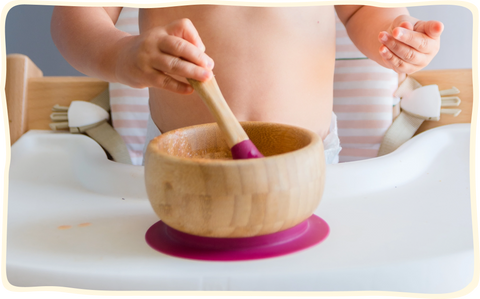Cart (0)
There is nothing in your bag.

Let's add some items.
There is nothing in your bag.

Let's add some items.

Yay, your baby has reached their Month 5 milestone! They may be ready to start weaning and exploring solid foods. As a parent, you may experience a range of emotions from excitement and wonder to nervousness and overwhelm. You’re not alone! Our Slurrp It Up team (of parents and nutrition experts) is here to help you and your baby enjoy the infant weaning experience!
Every baby is unique, so if your little one isn't quite ready to wean, that’s alright. This Course is your friendly guide – where you can get simple, accurate information along with expert tips on weaning introduction, introducing foods, and safe weaning foods and stages. Whenever you and your baby are ready, come visit this guide. 😀
Here are the 3 main types or methods of weaning that parents usually follow — these are often described as different weaning stages.
Which Time of the Day Should I Start My Baby’s Solid Food Journey?
As a new parent, starting solids can be an exciting but confusing experience. There really is no specific time to introduce new foods to your little one.
We recommend picking a time when you and your baby are relaxed and happy, perhaps 30–40 minutes after a breast feed. At this point, babies are usually in a good mood (not cranky) and have room in their tummy to try new flavors and weaning first foods or other healthy food for infants.
Honestly, there is no right or wrong approach to weaning your baby. While this Guide can equip you with the information you need, choose whatever approach resonates with your parenting style and your way of life.

Spoon-led weaning is a familiar approach for many parents. In this style of weaning, babies are spoon-fed purees and mashed food. This kind of food is easier for the child to swallow and consume than whole foods. Spoon-led approaches are a great way to introduce texture slowly and to ensure iron-rich weaning foods for infants are included early on.
Traditionally, in India, parents start weaning children off breast milk by feeding “dal pani” or “rice pani.” However, dal/rice pani is not recommended as a first food by our experts.

Here, babies are encouraged to self-feed finger foods, which are small pieces of food that babies can pick up and bring to their mouth. This allows them to explore different flavors and textures because they touch the food with their fingers and feed themselves. They learn to become independent eaters too. Finger foods for babies include soft, steamed foods (discussed later in detail). This style is commonly referred to as infant led weaning (or baby-led weaning) and is ideal for babies who enjoy grabbing and exploring food.

This combines spoon-led and baby-led weaning, which is a commonly preferred method by parents. Babies are spoon-fed purees and mashed food while at the same time they are offered whole foods (soft/steamed) that they eat by themselves.
Combination weaning lets parents have more control over what their baby is eating, to ensure they are getting essential nutrients. At the same time, babies learn to self-feed at their own pace. Many parents start with gentle purees and move to weaning foods and finger foods as the baby becomes more confident.











Check your WhatsApp for Slurrp It Up’s first message to you. ☺






